Table of Contents
Introduction
Halal Meat Statistics: Halal meat is meat that’s prepared by Islamic dietary laws, which specify what’s permissible and prohibited for Muslims when it comes to consuming meat.
The meat must come from animals like cattle, sheep, goats, and poultry. Which are considered Halal, while pork and its by-products are strictly forbidden (Haram) in Islamic dietary regulations.
Many countries have organizations or agencies that grant certifications for Halal meat products. Ensuring that the meat is produced and processed following Halal standards.
It plays a vital role in the diets of Muslims worldwide and requires strict adherence to religious guidelines throughout the meat production process.
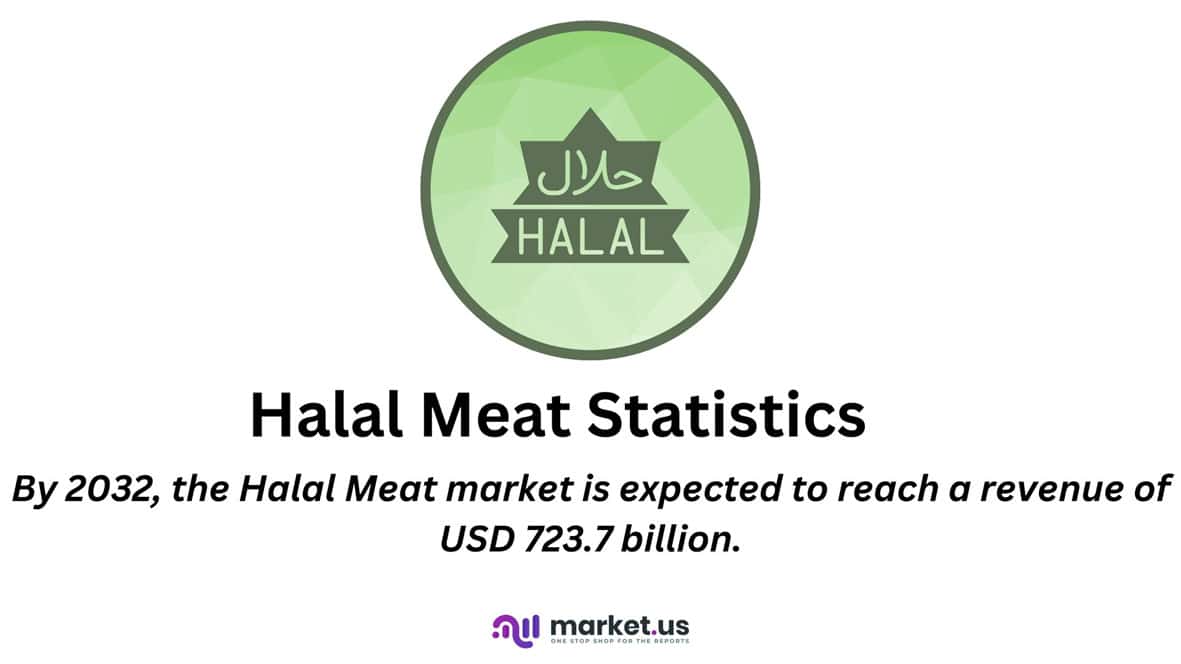
Editor’s Choice
- In 2023, the Halal meat market revenue stood at USD 294.4 billion.
- In terms of market share distribution among end-users, the food service sector dominates with a substantial 65% share, highlighting its prominent role in the market.
- In Saudi Arabia, the Saudi Arabian Standards Organization (SASO), was established in 1972. It has been designated to establish Halal standards, ensuring the authenticity of Halal food.
- Brazil stands as the leading exporter of halal meat among nations, boasting a substantial trade value of $5.19 billion.
- According to Volza’s Global Import data, the global import of Halal meat reached a total of 215,000 shipments.
- Brazil emerged as the leading exporter, with a significant export value of $16.2 billion.
- In 2021, the total value of global consumer spending within the Halal market across various categories was substantial. With Halal Food leading the way at $1,267 billion (or $1.267 trillion).
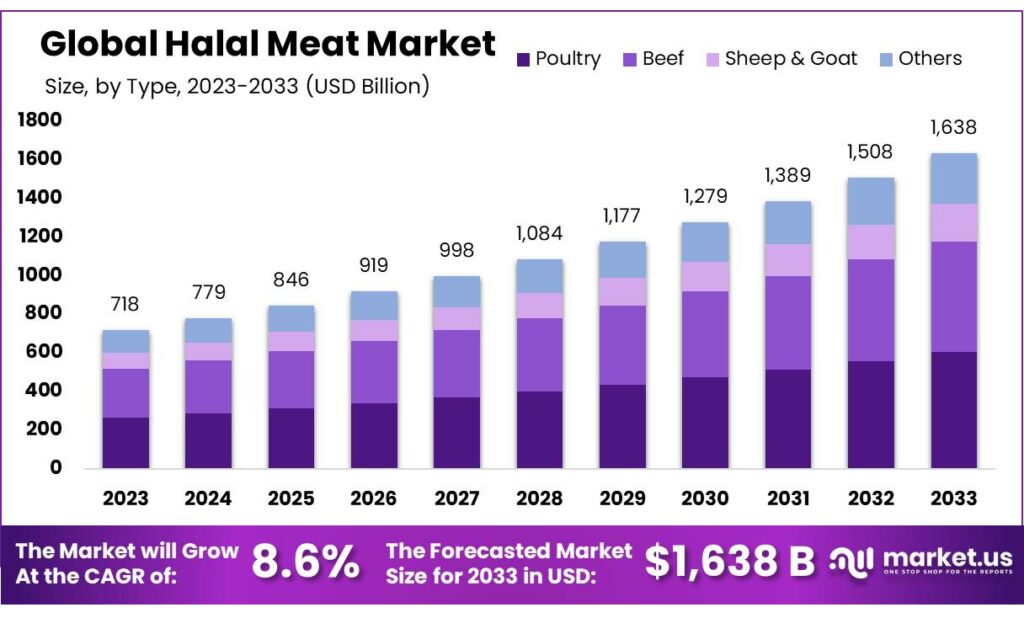
Global Halal Meat Market Overview
Halal Meat Market Size Statistics
- The global Halal meat market is on a steady growth trajectory, with revenues projected to increase over the coming years at a CAGR of 9.7%.
- In 2022, the market revenue stood at USD 265.9 billion and is expected to reach USD 294.4 billion in 2023.
- The growth is anticipated to continue, with estimates of USD 326.1 billion in 2024, USD 361.1 billion in 2025, and USD 399.9 billion in 2026.
- As we move towards 2027 and beyond, the market is forecasted to experience substantial expansion. Reaching USD 442.8 billion in 2027, USD 490.4 billion in 2028, and USD 543.1 billion in 2029.
- The positive trend is set to persist, with projected revenues of USD 601.4 billion in 2030, USD 659.7 billion in 2031, and USD 723.7 billion in 2032. Reflecting a robust and promising outlook for the global Halal meat market.
(Source: Market.us)

Global Halal Meat Market Share – By End-user Statistics
- In terms of market share distribution among end-users, the food service sector dominates with a substantial 65% share, highlighting its prominent role in the market.
- On the other hand, the household segment holds a significant but relatively smaller share of 35%.
- This division indicates that the food service industry plays a leading role in the utilization of the product or service. Households also contribute significantly to the market’s consumption, albeit to a somewhat lesser extent.
- This balance in market share distribution underscores the importance of catering to both sectors within this particular market.
(Source: Market.us)
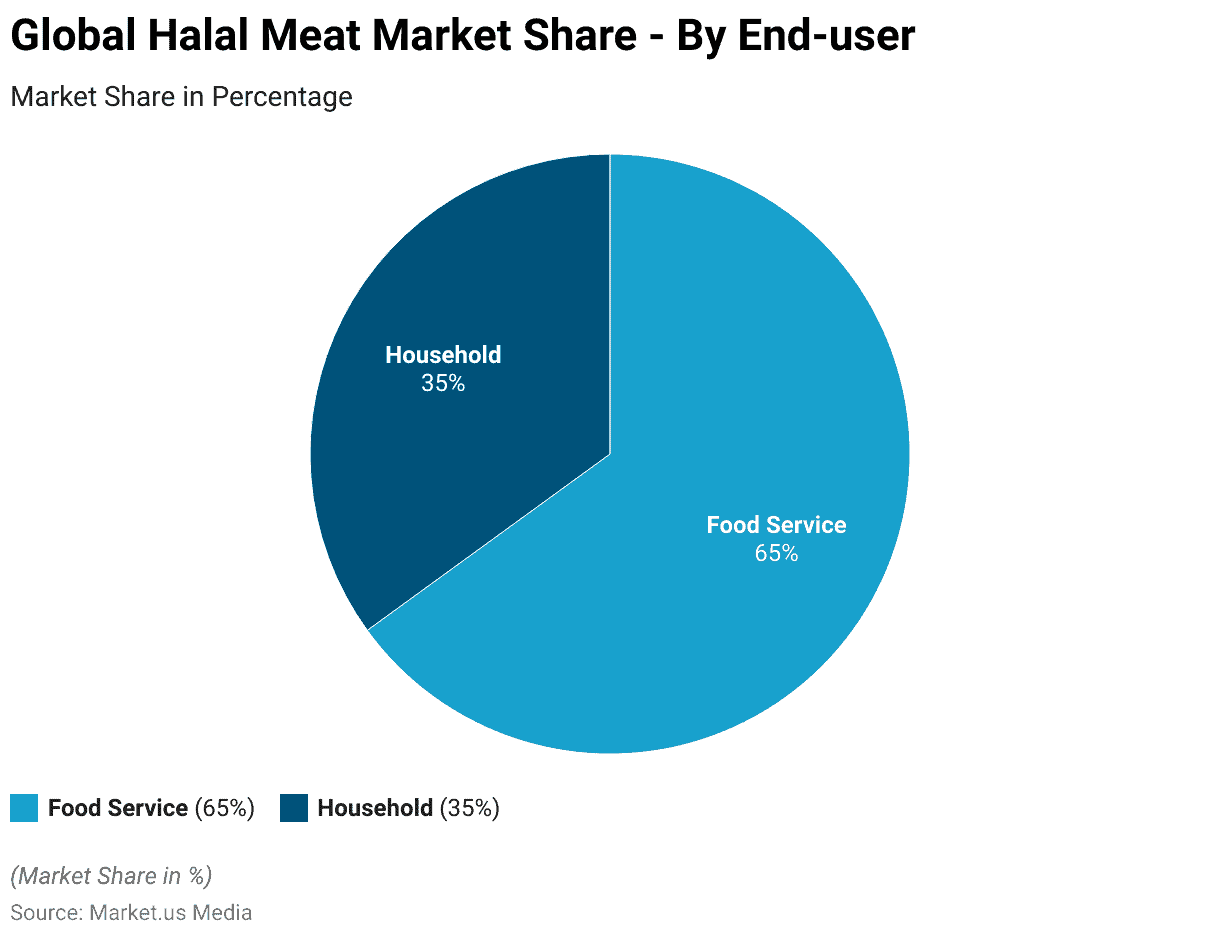
Halal Meat Market Share Sector – By Industry Statistics
- Within the dynamic landscape of the Halal sector, various industries contribute to its growth and significance, each holding a distinct share.
- Islamic Finance takes the lead with the largest share, commanding 43% of the Halal market.
- This sector focuses on financial products and services adhering to Islamic principles. Attracting a substantial portion of the Halal-conscious consumer base.
- The Food industry closely follows, accounting for 36% of the sector, as consumers prioritize Halal-compliant food and beverages.
- Fashion holds a 7% share, reflecting the growing demand for modest and Halal-compliant clothing options.
- Media and recreation contribute 6%, indicating the importance of Halal-friendly entertainment and leisure activities.
- Travel and Tourism represent 4%, as travelers seek experiences aligning with their Halal requirements.
- Finally, Cosmetics and Pharmaceuticals each hold a 2% share. Underlining the significance of Halal-certified products in the beauty and healthcare sectors.
- Together, these industries shape the diverse and evolving landscape of the Halal sector. Driven by consumers who prioritize products and services in line with Halal principles.
(Source: ISE Halal)
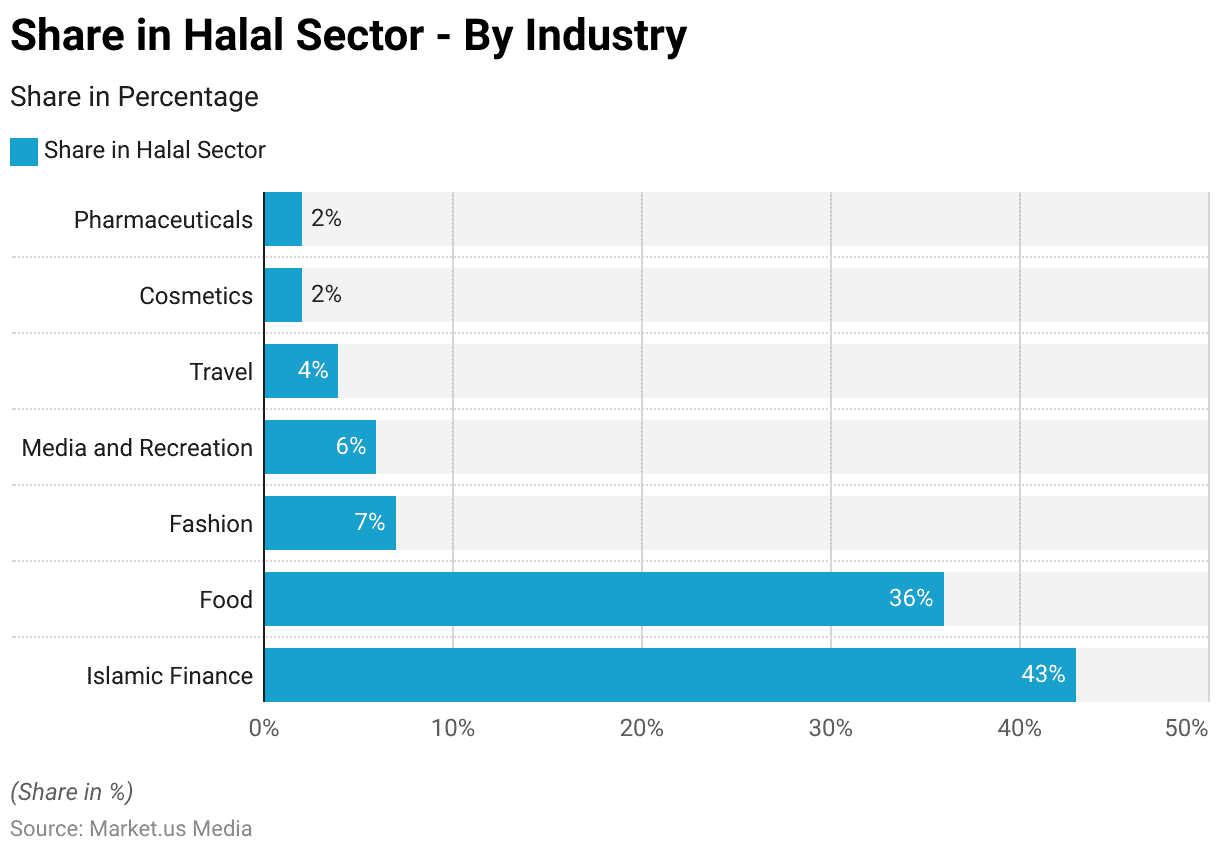
History of Halal Certification Statistics
- In 1972, Singapore launched its Halal certification services under the Majlis Ulama Islam Singapore (MUIS), an organization founded in 1967, responsible for ongoing Halal certification oversight.
- In Saudi Arabia, the Saudi Arabian Standards Organization (SASO), established in 1972, has been designated to establish Halal standards, ensuring the authenticity of Halal food.
- Australia saw the introduction of Halal meat certification in 1977 by the Australian Federation of Islamic Councils (AFIC). Making it the inaugural and most seasoned certification body in the country for Halal products.
- Similarly, the Islamic Society of North America (ISNA) was founded in the United States in 1981. Holding recognition from JAKIM and currently collaborating with the Islamic Food and Nutrition Council of America (IFANCA) as an accrediting body for the development of Halal standards in the United States.
- FAMBARS, Brazil’s second Halal certification entity, was founded in 2017.
- It holds accreditation from both the Gulf Accreditation Center and the Emirates Authority for Standardization and Metrology.
- FAMBARS provides Halal certification across 204 different industries, encompassing 45 slaughterhouses and 14 chicken refrigeration facilities.
(Source: Journal of Psychology and Well-being)
Top Halal Meat Exporting Nations
- Brazil stands as the leading exporter of halal meat among nations, boasting a substantial trade value of $5.19 billion.
- Following closely behind, Australia secures the second position with exports worth $2.36 billion. While India trails in third place with $2.28 billion.
- Other notable contributors to the global halal meat export market include France with $0.8 billion, China with $0.7 billion, Sudan and South Sudan combined at $0.63 billion, the Netherlands at $0.59 billion, Spain at $0.56 billion, Somalia at $0.47 billion, and Turkey at $0.46 billion.
- These countries collectively play a significant role in supplying halal meat products to markets worldwide, reflecting the global demand for such products.
(Source: Euromeat)
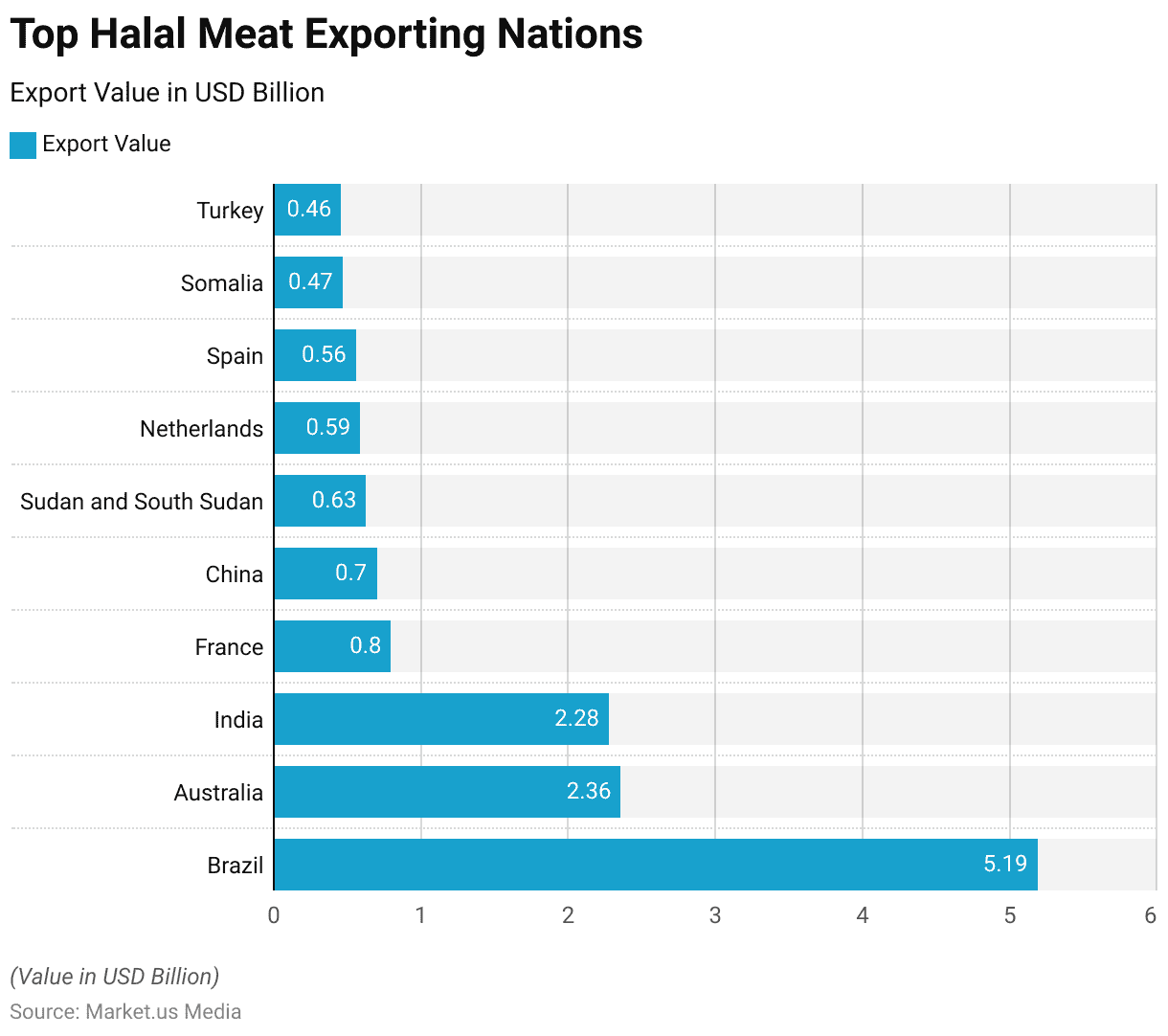
Export of Halal Meat to OIC Countries
- In the year 2019, several countries made substantial contributions to the export of halal meat to nations within the Organization of Islamic Cooperation (OIC).
- Brazil emerged as the leading exporter, with a significant export value of $16.2 billion.
- India closely followed with an impressive export value of $14.4 billion. While the United States secured the third position with exports worth $13.8 billion.
- Russia and Argentina also made notable contributions, with export values of $11.19 billion and $10.2 billion, respectively.
- These figures reflect the pivotal role played by these countries in supplying halal meat to OIC nations. Meeting the dietary and cultural preferences of Muslim populations worldwide.
(Source: Journal of Psychology and Well-being)

Top Halal Meat Importing Nations Statistics
- According to Volza’s Global Import data, the global import of Halal meat reached a total of 215,000 shipments.
- These shipments were sourced from 722 different suppliers and received by 6,705 importers worldwide.
- India, Pakistan, and Brazil emerged as the primary countries from which the world imports the majority of its Halal meat.
- Vietnam took the lead as the largest importer of Halal meat, with a substantial 70,738 shipments.
- Malaysia secured the second position with 23,133 shipments, while the United Arab Emirates claimed the third spot with 19,691 shipments.
- This data underscores the significant global demand for Halal meat and the prominence of these countries in meeting this demand as key importers of Halal meat products.
(Source: Volza)
Halal Consumer Spending Statistics
- A 2016 global survey by Frost & Sullivan revealed that Halal consumers worldwide collectively spent a substantial $2 trillion, covering food, beverages, and various lifestyle aspects.
- This trend indicates that the influence of the Halal industry goes beyond food products. Expanding into sectors like tourism, pharmaceuticals, cosmetics, and more.
- As consumer demand continues to rise, the Halal market diversifies. Encompassing various industries such as healthcare, toiletries, and logistics, among others.
- For instance, in 2016, the tourism sector alone saw Halal consumers spending $169 billion. As projected, this figure reached $283 billion in 2022, highlighting the dynamic and expanding nature of the Halal industry driven by consumers embracing Halal principles in various aspects of their lives.
(Source: Frost & Sullivan)
Halal Meat Consumer Spending – By Category Statistics
- In 2021, the total value of global consumer spending within the Halal market across various categories was substantial, with Halal Food leading the way at $1,267 billion (or $1.267 trillion).
- This was followed by Modest Fashion at $295 billion, Media & Recreation at $231 billion, Muslim-friendly travel at $102 billion, Pharmaceuticals at $100 billion, and Cosmetics at $70 billion.
- The Halal market encompassed a diverse range of industries, reflecting the significance of Halal principles in consumers’ lives.
- Looking ahead to 2025, the forecast indicates a significant expansion in Halal consumer spending across these categories.
- Halal Food is expected to reach $1,668 billion, showing continued growth in this fundamental category.
- Modest Fashion is projected to grow to $375 billion, reflecting the increasing demand for modest clothing options.
- Media & Recreation is estimated to rise to $308 billion, highlighting the significance of Halal-friendly entertainment and leisure activities.
- Muslim-friendly travel is forecasted to increase to $189 billion. Demonstrating the growing interest in travel experiences that align with Halal requirements.
- Pharmaceuticals are expected to reach $129 billion, while Cosmetics are projected to grow to $93 billion.
- These forecasts underscore the continued and robust expansion of the Halal market. Driven by consumer preferences and values that prioritize products and services in line with Halal principles.
- The Halal industry is poised to play an increasingly substantial role in the global economy as these categories continue to evolve and thrive.
(Source: Statista)

Consumer Preferences on Halal Meat Statistics
- A significant majority of individuals who are aware of Halal dietary practices abstain from consuming Halal foods, citing two primary reasons: either they do not adhere to the Islamic faith (64%) or they lack sufficient knowledge about Halal-certified foods (61%).
- Among Americans who are familiar with Halal, there is a prevailing belief that Halal-certified food products are more humane (44%), offer greater freshness (42%), and are healthier (41%) compared to non-Halal-certified foods.
- Consumers who are knowledgeable about Halal guidelines tend to prioritize nutritional content (81%) and ingredient transparency (76%) when shopping for food, distinguishing them from those less acquainted with Halal practices (74% and 62%, respectively).
- However, even among those who actively seek Halal-certified products, there is a notable challenge in locating them.
- The survey conducted by IFANCA reveals that over half of Americans with awareness of Halal (52%) and a significant 72% of regular Halal consumers encounter difficulties in finding Halal-certified foods when shopping.
(Source: Islamic Food and Nutrition Council of America (IFANCA))
Recent Developments
Merger and Acquisition:
- Tyson Foods’ Acquisition of Amigos Meat: Tyson Foods, is one of the largest meat producers globally. Completed the acquisition of Amigos Meat, a leading supplier of halal-certified meats.
- This strategic move expands Tyson Foods’ presence in the halal meat market and strengthens its commitment to catering to diverse consumer preferences. The acquisition was valued at $150 million, reflecting the growing demand for halal-certified products.
Consumer Trends and Preferences:
- There is a noticeable increase in the demand for quality halal meat not only from the Muslim population but also from non-Islamic consumers who are drawn to its health and hygiene benefits.
- In North America, the consumption of halal meat is becoming a lifestyle choice beyond the Muslim community due to its strict health and hygiene standards.
Product and Regional Developments:
- Poultry leads in the product types segment due to its versatility and health benefits, making it a popular choice globally.
- The Asia-Pacific region remains the largest consumer of halal meat, with significant growth expected in the coming years.
Funding:
- Midamar Corporation’s Expansion Funding: Midamar Corporation, a prominent supplier of halal meats, secured $20 million in funding to support its expansion initiatives and enhance its production capabilities.
- The investment will enable Midamar Corporation to meet the growing demand for halal-certified meats both domestically and internationally, particularly in regions with significant Muslim populations. This funding underscores the potential for growth within the halal meat market.
Innovations and Certification:
- Halal certification is increasingly sought by manufacturers to ensure compliance with dietary laws and to cater to the growing market demands.
- Innovations such as the use of blockchain technology are being explored to ensure and verify halal compliance throughout the supply chain.
Challenges and Opportunities:
- The industry faces challenges such as the lack of universally recognized halal standards, which complicates global trade in halal meat.
- Opportunities abound in catering to the growing Muslim population, projected to reach 2.2 billion by 2030, which is driving demand for halal-certified products globally.
Conclusion
Halal Meat Statistics – In brief, Halal meat holds significant importance within Islamic dietary traditions, governed by stringent religious regulations. It has experienced notable expansion and diversification, branching out into various industries.
The global Halal meat market is on the rise, generating substantial revenues and making its mark in both the food service and household sectors.
Upholding Halal standards, which include ethical sourcing and humane slaughtering practices, is paramount to maintaining the confidence of Halal-conscious consumers.
The verification of product authenticity is facilitated by Halal certification, administered by certification bodies in numerous nations.
In essence, the Halal meat industry mirrors a dynamic and expanding market, shaped by consumers who prioritize products aligned with their religious and cultural convictions.
FAQs
Halal meat refers to meat prepared and processed by Islamic dietary laws and guidelines, ensuring it is permissible for Muslims to consume.
Halal meat preparation involves invoking the name of Allah (God) before slaughter, using a sharp knife for a swift and humane cut, ensuring complete blood drainage, and avoiding cross-contamination with non-Halal products.
Generally, animals like cattle, sheep, goats, and poultry are considered Halal. However, specific guidelines may vary by region and interpretation.
Pork and its by-products are strictly forbidden (Haram) in Islamic dietary laws. Any food or ingredient derived from pigs is not permissible.
Halal certification verifies that products, including meat, comply with Halal standards and are suitable for consumption by Muslims. It assures authenticity and compliance with religious guidelines.
Discuss your needs with our analyst
Please share your requirements with more details so our analyst can check if they can solve your problem(s)



